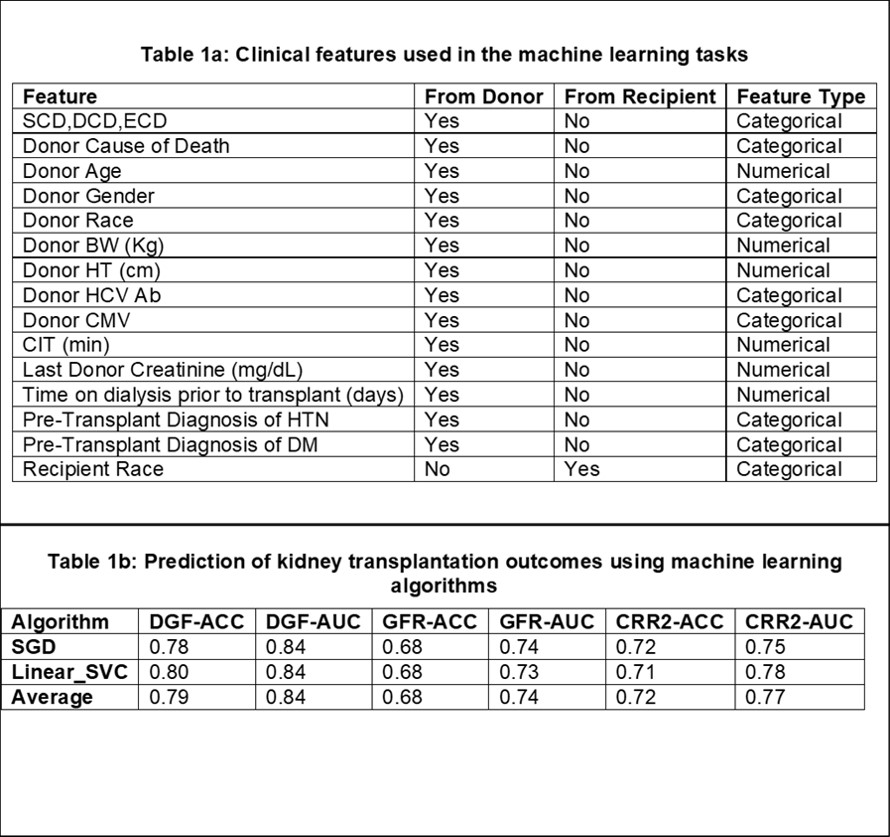Predicting Renal Graft Function Post Transplantation Using Clinical and Biological Features Supported by Machine Learning Algorithms
1Department of Genetics, University of Tennessee Health Science Center, Memphis, TN, 2Dept of Surgery, Transplant Research Institute, James D. Eason Transplant Institute, University of Tennessee Health Science Center, Memphis, TN, 3Northwestern University, Chicago, IL, 4Albert Einstein Medical College, New York, NY
Meeting: 2020 American Transplant Congress
Abstract number: A-051
Keywords: Kidney, Kidney transplantation, Outcome, Prediction models
Session Information
Session Name: Poster Session A: Kidney Deceased Donor Selection
Session Type: Poster Session
Date: Saturday, May 30, 2020
Session Time: 3:15pm-4:00pm
 Presentation Time: 3:30pm-4:00pm
Presentation Time: 3:30pm-4:00pm
Location: Virtual
*Purpose: Predicting renal function post transplantation is a frequent challenge impacting physician decisions and patient quality of life. We aimed to develop a composite score for predicting short-term outcomes post kidney transplantation using machine learning/deep learning methods.
*Methods:
We developed machine learning models to predict three clinical outcomes post kidney transplantation (KT): 1) Delayed Graft Function (DGF), 2) Glomerular Filtration Rate (GFR) (±45 mL/min/1.73 m2 at 1 month post KT), and 3) creatinine reduction ratio (CRR2) (± 30 ), using graft transcriptome data and 15 clinical/demographic features of donors and recipients in 198 available deceased kidney transplant followed for more than 4 years. Clinical features used in the machine learning tasks are shown in [Table 1a].
*Results: We used two machine learning methods, Stochastic Gradient Descent (SGD) and Support Vector Machine (SVM), to model the complex relationships between the molecular and clinical features and the outcomes of the kidney transplantation. We applied the leave-one-out cross-validation process to train and test the machine learning models. Two evaluation metrics were used to access the performance of machine learning models: 1) prediction accuracy (ACC), and 2) area under the Receiver Operating Characteristics curve (AUC). Both methods successfully predicted the three outcome measures with AUC between 0.75-0.85 [Table 1b]
*Conclusions: Our data suggests that machine learning algorithms may help to predict graft function post transplantation, especially when combining clinical and biological donor/recipient parameters.
To cite this abstract in AMA style:
Gao Y, Cui Y, Kuscu C, Kuscu C, Gallon L, Bajwa A, Akalin E, Eason JD, Maluf D, Mas V. Predicting Renal Graft Function Post Transplantation Using Clinical and Biological Features Supported by Machine Learning Algorithms [abstract]. Am J Transplant. 2020; 20 (suppl 3). https://atcmeetingabstracts.com/abstract/predicting-renal-graft-function-post-transplantation-using-clinical-and-biological-features-supported-by-machine-learning-algorithms/. Accessed November 23, 2025.« Back to 2020 American Transplant Congress

